Vintage Rewind: Arp Odyssey
As we continue to enjoy the renaissance for new and vintage synthesisers, it’s time to look back at the ARP Odyssey, and look forward at its current forms, with the recent release of the ‘FS’ model, a full-size clone… When you talk about vintage American synth companies, there are several names that immediately spring to […]
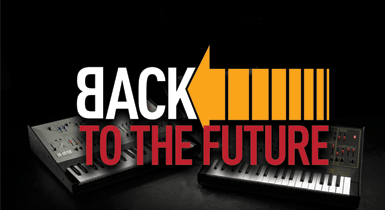
As we continue to enjoy the renaissance for new and vintage synthesisers, it’s time to look back at the ARP Odyssey, and look forward at its current forms, with the recent release of the ‘FS’ model, a full-size clone…
When you talk about vintage American synth companies, there are several names that immediately spring to mind, such as Bob Moog, Dave Smith (Sequential Circuits), Tom Oberheim, Don Buchla and, of course, Alan Robert Pearlman, whose initials became synonymous with a number of classic analogue machines.
ARP Instruments Inc. was founded in 1969 by Pearlman, along with collaborator and designer David Friend. Originally branded as Tonus, ARP entered the fledgling synth industry and very quickly rose to notoriety with the production of the ARP 2500 in 1970, followed swiftly by the ARP 2600 later that year. These instruments quickly gained acceptance with musicians including Stevie Wonder and jazz-fusion master Joe Zawinul, who toured with two 2600s with his band Weather Report.
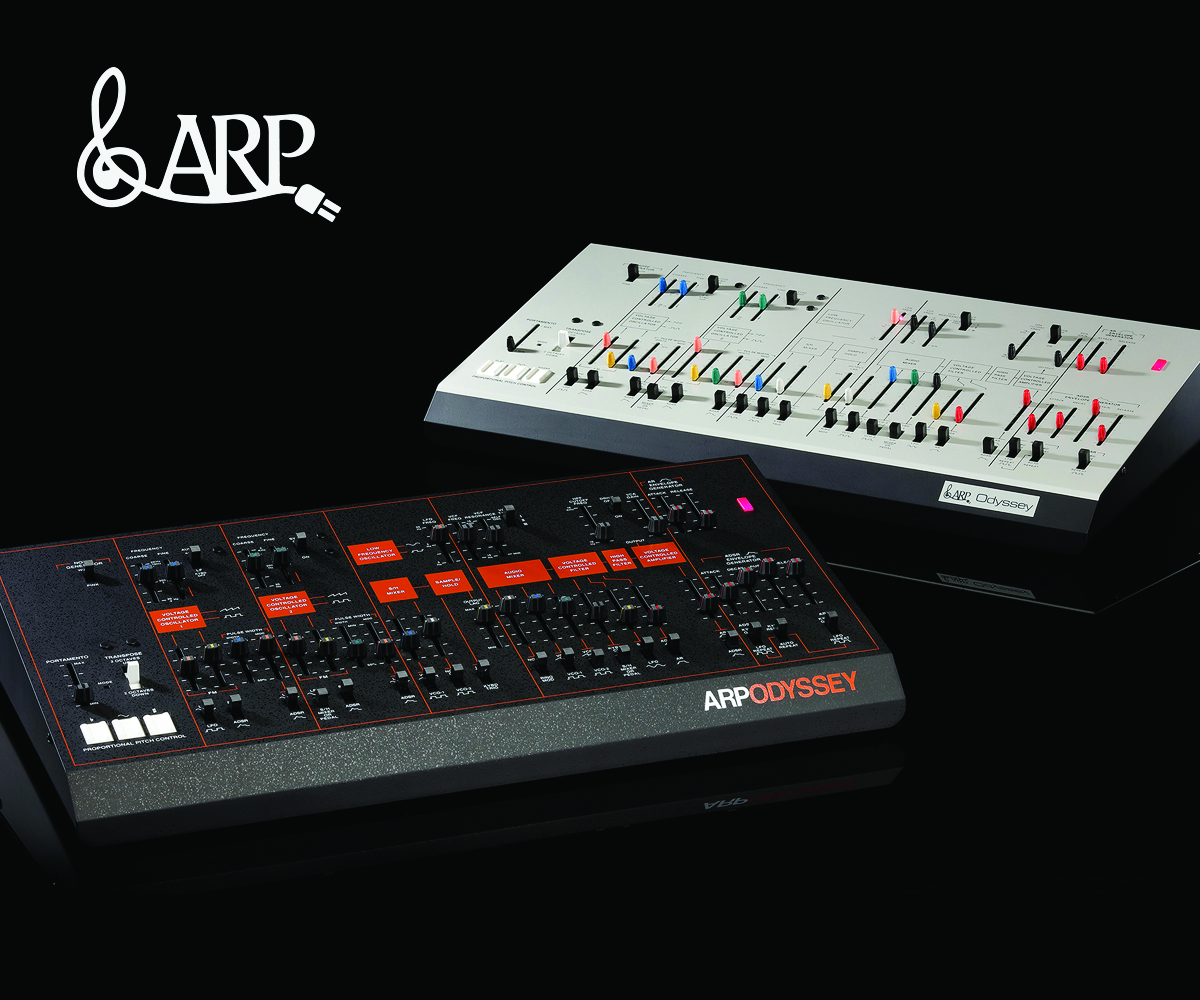
The acceptance and wide usage of the Minimoog demonstrated an appetite for a more compact synth, away from the large scale modulars. It was also a more affordable concept and led to the release of the ARP Odyssey in 1972 which stayed in production until 1981. For many, the Odyssey was a perfect companion to the established Minimoog, offering an altogether sharper sound and timbre, to the smoothness of the Moog.
As such, it became almost as commonplace in the recording industry as the Mini. Loved and employed by pioneers and pop artists alike, the Odyssey could be found in studio and live settings for early pioneers such as Kraftwerk, Yellow Magic Orchestra, Jean-Michel Jarre and the BBC Radiophonic Workshop, but was equally at home with the likes of ABBA and ELO, with a significant following from other jazz legends, such as Herbie Hancock and Chick Corea. That’s quite a varied collection of artists, for a synth that is often placed behind the Minimoog in order of popularity.
Quirks and misunderstandings
The first point to make is that the architecture of the Odyssey is very firmly based on the subtractive ideal. It makes use of two Voltage Controlled Oscillators (VCOs), both of which are switchable between Saw and Square waveforms, and are both fully sweepable in frequency. This means that, like many modulars, you’ll need to make sure that you tune your VCOs to an appropriate note before starting work, but once done, you can tune the second oscillator to any interval you might desire.
What makes this even more intriguing is that it is possible to mix the levels of both VCOs, and also mix in a third source, which is switchable between White or Pink Noise, and a ring modulator, and this is where great tonal contrast can be obtained.
The Odyssey is actually ‘Duophonic’, which is to say that it will play monophonically, or can split the oscillators across two notes, to play chords. By invoking the Ring Modulator, harmonics start to appear when chords are being played, and you suddenly find the most beautiful harmonic overtones appearing – often filling in the missing note of a given triad when playing an open fifth, and firmly playing by the laws of physics and the harmonic series.
“The ARP Odyssey became as commonplace as the Minimoog in the recording industry”
Play something which is away from this diatonic ideal and you’ll find the Odyssey reacts with a gnarly appetite, reaching for your ears and biting them off. You have been warned. But you do have options to tame the beast, with both a Low Pass and High Pass filter, although which flavour you might have was dependent on which model you purchased.
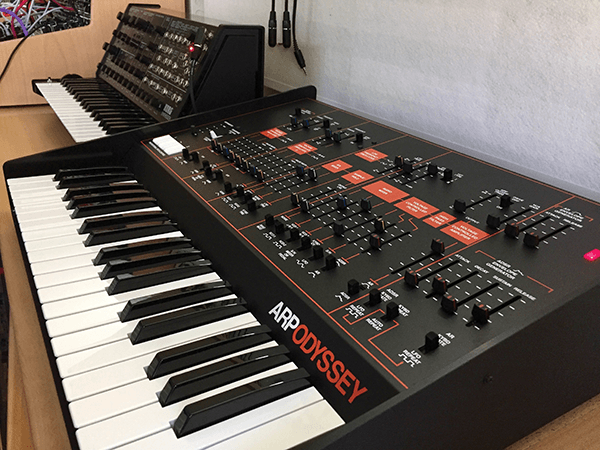
One wonderful quirk of the Odyssey is its ability to control Sample and Hold (or Random) CVs via the LFO, or on a per-note trigger basis. This means that you can set a randomised CV to occur on every note you play, which can be sent in the direction of either of the oscillator frequencies or the Low Pass filter cut off. In its former state, a superb sense of wandering pitch detuning can be obtained, offering a beautifully unsettling quality. It’s like an out-of-tune analogue, but you can dictate how much, and if you wish, can be sent to complete extremes.
Now, I have to be honest at this point, and hold up my hands to the fact that when I first got my hands on an Odyssey, 20-odd years ago, there was a fair degree of head scratching, not least of all in trying to get a sound out of it. Feeling like a bit of a chump about this, I then discovered that I was absolutely not the only person to have encountered this, including some well-respected friends who should also know better, but no, we’re all members of the ‘It’s not making any noise’ club.
A friend of mine, who works in retail, even reported that with the recent Korg reissues, he had a fellow come into his shop to try one out and spent an hour trying to get a noise, before he sheepishly asked for help, and there’s actually a very good reason for this. Apart from the more obvious factors of making sure that the oscillators are turned up in the mixer section, and the filters being open, there are a number of gating options, which could easily catch the user out.
These include the ability to route to one of two Envelopes, with both AR and ADSR available, either from the keyboard trigger, or from the LFO, which can assist with note triggering and hence reduce the long term risk of Repetitive Strain Injury significantly, if you like your 80s basslines.
Droning and the gating
During the mid-years of the BBC Radiophonic Workshop, the ARP Odyssey became something of a favourite with certain composers, so much so, they used to have one on a trolley and wheel it around BBC Maida Vale, while the in-house composers argued over who would get to use it next. One of the reasons for this was its ability to play drones, in a very similar way to a modular synth, as the dedicated VCA Gain fader would allow the signal to pass through the VCA, without any need for a manual or external trigger.
This meant that your hands would remain free to tinker with the timbre, while the drone continued, which as any self-respecting TV composer knows, makes it sonic gold for certain types of show. TV directors and producers from the early 80s just loved a drone, and the Odyssey was only too happy to assist in this capacity, with ease and simplicity. But if droning wasn’t your thing, the comprehensive LFO-based gating options would allow for easy repetition of notes, either as a straight Gate On/Off or through an envelope.
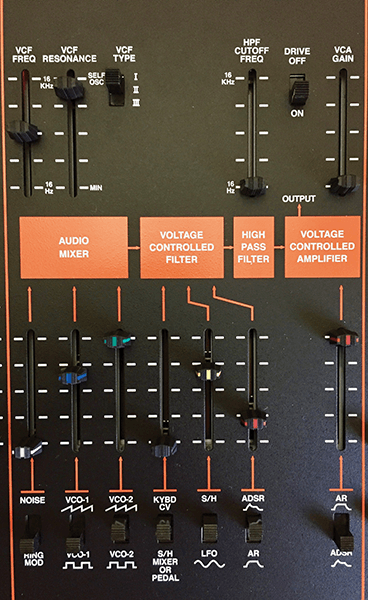
Three… is the magic number
During the life of the Odyssey, which was considerable to say the least, there were three incarnations, or at least in terms of major release. ARP was prone to tinkering with these things and there were other subtle changes along the way, but generally speaking, each of the three models lasted for a three-year period, with an amazing sense of symmetry.
The most obvious clue as to the model was the colour of the synth fascia; the Mk1 was a White Fascia design, while the Mk2 switched to a Black fascia, with Gold legends. Both of these designs offer rather spindly potentiometer controls, while the Mk3 gave rise to the classic Black and Orange design, which for many has become the sign of an ARP, thanks to its widespread use across their other products.
“I’ll be honest that 20 years ago, I was a member of the ‘It’s not making a noise’ club…”
Apart from the obvious appearance, the Mk 1 and 2 also offered a pitch wheel for note bending, which was superseded on the Mk3 by pressure pads, being known as Proportional Pitch Control. It’s a mystery why ARP tried to buck the mod-wheel trend here, as neither of these solutions is particularly elegant when playing, with the ‘PPC’ option on the Mk3 being very hard to control indeed.
However, the other big difference between designs was the filter type, which varied considerably between all three models. The Mk1 had the most aggressive filter by far, with the LPF being a 2-pole design, offering similarities sonically to an Oberheim SEM filter.
The Mk2, on the other hand, switched to a 4-pole design, which offered similarities to the Moog ladder filter, and was altogether richer, but for many lacked the sheer grunt of the Mk1, 2-pole design. Some later Mk2 models also started to use ARP’s own filter chip, the 4057, which became fully implemented into the Mk3 design, along with some other general improvements, which made the Mk3s more abundant in supply.
The Mk3 made use of an internal steel frame, making it heavier and more robust, but on the other hand, ARP made a slight change to the design of the keyboard, allowing the notes to overhang the chassis, more so than the earlier models. This meant that it was all too easy to snap off a note, with the upper and lower ‘C’ notes regularly taking a bashing and requiring replacement, but the Mk3 also included a balanced XLR audio output, alongside a quarter-inch jack, making for a better signal output and much preferred for live use as a result.
On a personal note, and much as I love the ARP Odyssey, you have to conclude that across the three model revisions, it comes across as having a pretty chequered past. I almost think of it as ‘The Lord giveth, and then taketh away’ with each revision. Curious – but for many, this is all part of the absolute charm of this classic synth.
Catch a Karp!
If, like me, you have been hankering after an Odyssey for a while, but been put off by the high price tags and large number of snapped keys which seem to come with the second-hand territory, then you could easily look into the prospect of getting one of the recent reissues, which have been made under licence by Korg, with additional help from David Friend, who was one of the original Odyssey designers.
These ‘Karp’ Odysseys, as they are described, offer more than a passing resemblance: in fact, according to certain Odyssey experts, you would literally not be able to tell the difference when heard side-by-side with an original, and you will get further enhancements that were simply not available on the originals. Firstly, there is the two-year-old Slim-Key version, which is still available from new, but with a number already available on the second-hand market.
The Slim-Key form factor makes it smaller in all ways, by around 12 per cent, and there is no doubt that the build quality is more ‘Okay’, than weapons-grade. You’ll also be able to find all three fascias, if you hunt around enough, although all three models are identical, even down to the filters, as Korg wisely decided to put all three filter types into every machine, with the ability to switch between them.
You’ll also find an Overdrive on the back end, which adds a wonderful element to the Filter too! Further enhancements include MIDI over USB and a MIDI five-pin socket (In only), albeit with the most basic of MIDI implementations, and the sensible addition of the XLR audio output. If the Slim Keys do not grab you, you could always go for the desktop version, which is largely the same, but with the keybed removed.
This is a good alternative if you really want to play or sequence it, but the final option is the recent release of the Odyssey FS, which stands for ‘Full Size’ – and it certainly is! These are hand-made in America, and really are as good, if not better than the originals, in many respects. You’ll get the full-on original sound, along with modern connectivity, and a full-size panel and keyboard, but you will also get something which is really well built, as is obvious from the pot and switch actions.
“It was all too easy to snap off a note, with the upper and lower Cs regularly taking a bashing”
Strangely, the keybed feels cheaper in quality, which is apparently down to the ability to find a non-velocity-based, good-quality action, which would be suitable, but it’s not bad, and I’ve played far worse. Not surprisingly, the FS version comes with a rather hefty price tag of £1,299 RRP, but if you have the money to afford one of these, your biggest issue is likely to be how you can get one! Korg have allegedly only made 100, in varying numbers of the three fascia types, which is making them rather hard to find.
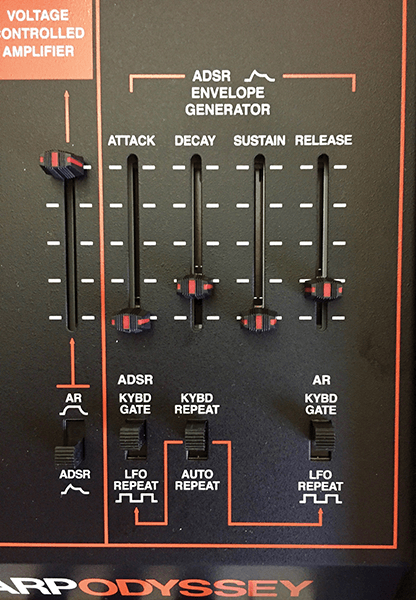
I managed to get hold of one myself, but only by placing a hefty deposit some months ago, when they were first announced, such is the allure of the full-size reissue of this classic. But don’t be disheartened, the slim-key version is just as great sounding as the FS, and frankly, for the money, you’ll find it hard to beat, as good analogue synths go.
The final reckoning
There is no doubt, this is a classic analogue monster in all departments. It sounds different to other machines of the time, and it’s hardly surprising that it featured alongside Moog in numerous situations, as a direct result. I love the aggressive tendencies of the Mk 1 filter, along with the harmonic joys of the Ring Mod, but I also like that fact that, thanks to the numerous and comprehensive modulation switching, it has the occasional tendency to catch me out. But I am also thrilled that thanks to Korg, this old-school classic is having a very well deserved renaissance, which further seals its place in history.
In its original form, it’s a sizeable beast, which has some of those wondrous features that make it a 70s classic, not least of all in the curvature of the plastic, which forms the underbelly, as it wraps up around the body of the keyboard. To me, ARP is always identifiable by the Mk3 Black and Orange design, which sets it out from the rest of the bunch, and hence I’ve always been a sucker for the Mk3. But the longevity of the Odyssey, over its nine-year tenure, can be so securely defined by which colour you choose.
We’ve all got a favourite, and unlike many other machines, each colour really does sound different!